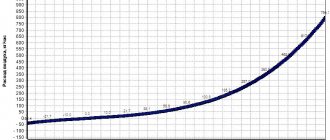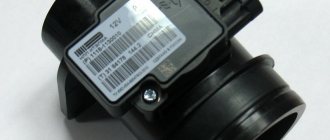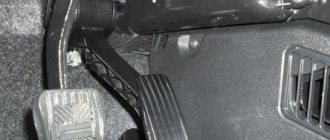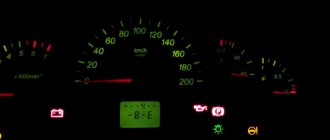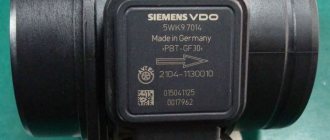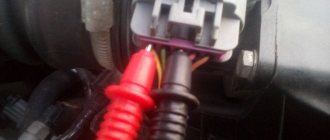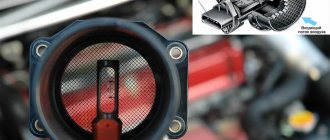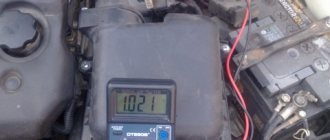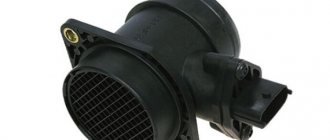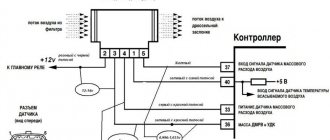01/26/2022 34 135 Sensors
Author: Ivan Baranov
The Bosch 116 mass air flow sensor or mass air flow sensor is a regulator designed to control the volume of air that enters the engine. This controller is one of the elements of electronic engine control systems with fuel injection. In this article we will try to answer the question of how models 116 and 037 differ.
[Hide]
Description
The mass air flow sensor (MAF) is located near the air filter to determine the amount of flow passing through the air filter. When a sensor fails, the controller usually generates an error, but if the sensor simply does not meet its original characteristics, this can affect the power characteristics of the machine.
How to check
You can check the serviceability of the sensor as follows: - If you notice that the car has begun to accelerate sluggishly and there is a suspicion of a mass air flow sensor, then you can check this in a simple way. 1. Disconnect the sensor connector. 2. Start the engine. 3. Engine speed should become more than 1500. Try to drive. If you feel that the car has become “faster”, then this indicates a malfunction of the mass air flow sensor; it should be replaced with a new one.
Differences between different versions of mass air flow sensors
There are 3 modifications of air flow sensors: 004, 037, 116. 004 was placed under the Rossiya 82 toxicity standards. 037 was installed on an ECU with a resonant DD and “Russia 83” or “Euro-1” standards. The 116 version was installed on Euro-1 and Euro-2 cars. The latest version of the MAF 116 has a built-in air temperature sensor. Therefore, sensors 004 and 037 (they do not have a temperature sensor) can be replaced with 116, but not vice versa.
Different versions of sensors differ slightly in calibrations. If you install a different version of the sensor (for example, 116 instead of 037), then you need to adjust its calibrations in the controller firmware.
Calibrations of versions 037 and 116 DMRV
Below are instructions for replacing the sensor.
The Bosch 116 mass air flow sensor or mass air flow sensor is a regulator designed to control the volume of air that enters the engine. This controller is one of the elements of electronic engine control systems with fuel injection. In this article we will try to answer the question of how models 116 and 037 differ.
Characteristic
On VAZ cars, the mass air flow sensor is mounted between the air filter element and the throttle hose. Today, products from the manufacturer Bosch are very popular among compatriots. Regardless of whether it is a universal Bosch sensor or, for example, spark plugs, quality from a German manufacturer can always give a head start to domestic products. Let's look at the main characteristics of regulators models 116 and 037.
116
DMRV 116 is designed to control and convert the air flow that enters the motor into voltage. The data transmitted by the regulator makes it possible to determine the operating mode of the power unit and calculate the cyclic filling of the cylinders with air flow. This filling is carried out in steady-state operating modes of the motor, which last no more than 0.1 seconds.
Let's look at the technical features that Bosch 0 280 218 116 has:
- the regulator operates on the principle of measuring air flow;
- the device provides accurate data, which ensures optimal fuel consumption;
- operating range varies from 8 to 550 kg/h;
- the output pulse level when measuring the range from 0 to 100% will be about 0.05-5 volts;
- As for power supply, the controller is powered from the vehicle’s electrical network, that is, 12 volts is enough for it;
- current consumption is about 0.5 ampere;
- the regulator can function normally in the operating range from 45 degrees below zero to 120 degrees;
- The service life of the Bosch 116 mass air flow sensor is about 3 thousand hours.
Bosch 116 device
037
As for the mass air flow sensor 037 from Bosch, the technical features will be similar. The controller consists of two main elements - working and control, as well as a heating resistor device. The air that enters the engine cools one of the controllers, while the electronic module converts the temperature differences between the controllers. In the event that sensor 280 218 037 fails, its options will be performed by TPS.
As mentioned above, the technical features of the models are the same:
- the operating range for normal operation varies in the region of 8-550 kg/h;
- when operating correctly, the controller will provide accurate data, making it possible to achieve optimal gas mileage (of course, if the engine is running in normal mode);
- since the element is used in a car, it is logical that it should be powered by 12 volts;
- the controller consumes about 0.5 ampere of current;
- the part can operate normally both at 45 degrees below zero and at 120 degrees of heat, this is its operating range;
- service life is at least 3 thousand hours;
- unlike model 116, the new mass air flow sensor 037 during calculations can produce an error of 2.5 percent (both downward and upward).
Regulator model 0280218037
What is the difference between sensors 037 and 116?
How can the regulators of these models differ from each other and is it possible to install 116 instead of 037? There are differences between these controllers, and the point is not in the MAF pinout. After all, if these models were the same, what would be the point of giving them different names?
So, how do the controllers differ from each other and is it possible to install model 116 instead of 037:
- The first difference that can be guessed based on the technical characteristics is that the 037 model can produce data with an error during operation. Of course, an error of 2.5% is not critical, but it does exist.
- Device 037 is intended for installation in VAZ 2111, 2112, 2123, 21214 cars, which are equipped with controllers M 1.5.4, January 5.1-5.1.3, etc.
- As for model 116, its use is relevant on Ladas 21114, 21124, 21214. Installation of this device is allowed on Kalina and Priora. Installation of the device is allowed on cars equipped with M 7.9.7 and January 7.2 controllers.
If you encounter a problem with the device not working, then when replacing it you need to install the same model that has already been installed. But it is worth considering that 037 is not a common option like 116, so it is more difficult to find. The latter, in turn, is more common, and its cost is lower.
Replacement is allowed, but experts do not recommend this. This is because these devices differ in their calibration, so in case of replacement, you will have to change the parameters of the control unit. And you can only get into the “brains” of a car if you understand what needs to be done and have minimal experience.
Good day!
The subject is this: I have a VAZ 21140 2004 model year. with brains BOSCH 7.9.7. On it the mass air flow sensor died, the readings are 1.02-1.04, depending on the case, and secondary signs: the revolutions drop when the clutch is depressed to 500-600, increased fuel consumption (11-12l/100km), difficult cold starts.
Making an “eternal” mass air flow sensor on ATiny13
This project appeared due to the reluctance to buy a part that had been in use for about 30 (thirty) years for a quite considerable amount of 3,000 - 5,000 rubles. We can say that this will be a test of the pen in circuit design and programming of microcontrollers. If you're interested, see the continuation below the cut.
Be careful there are a lot of photos!
So, we start propping up the bikes with crutches.
Input data
BMW E30 coupe 1986 with M10B18 engine (4 cylinders, 1.8L, injection):
How to check the flow meter on a VAZ 2115 yourself
- If the “Check Engine” light comes on on the dashboard, you can determine errors using OBD codes using a car scanner. However, such equipment is not always at hand.
- The initial check can be carried out by simply disconnecting the flow meter connector and comparing the behavior of the engine with and without the mass air flow sensor. After disconnecting a working sensor, the car's behavior should worsen. A broken flow meter when disconnected will not change the operation of the motor.
- And finally, a relatively accurate test using a multimeter. It is carried out in two stages. First, the power supply to the device is checked with the disconnected connector. From the ECU, 12 volts should be supplied to pin 2, and 5 volts to pin 4. Measurements are made relative to weight, with the ignition on and the engine turned off. Then the voltage of the sensor signal is measured at the connected connector in a resting state (ignition on, engine not running). To do this, you need to equip yourself with a relatively accurate multimeter that can measure voltage with an error of up to 1/100 volt.
Regarding ground, there should be a voltage of 0.99 to 1.02 volts at pin No. 5. It is possible to increase the value to 1.05 volts, but this indicates a high degree of wear on the mass air flow sensors.
Causes of malfunctions
In 90% of cases, this is contamination of sensitive sensors.
- a low-quality (not certified) or incorrectly installed air filter allows dust to enter the mass air flow sensor measuring channel;
- when operating the vehicle in wet weather or driving through puddles, droplets of water may enter the intake manifold;
- If the crankcase ventilation system does not work (damaged hoses, broken valve), drops of oil enter the air duct pipe.
Replacing the air flow sensor
The replacement procedure is as follows:
- First you need to loosen the clamp that secures the air duct, for this you use a Phillips-head screwdriver. The pipe itself can be dismantled.
- Disconnect the power connector from the regulator; to do this, simply press the latch at the bottom and pull the plug itself to the side.
- Next, using 10mm wrenches, you need to unscrew the two bolts. It may be difficult at this stage, so you can use a ratchet to unscrew the bolts quickly.
- The regulator can then be moved to the side and removed.
- The installation procedure is carried out in reverse order.
Photo gallery “Help in replacing the air flow sensor”
see also
Comments 67
Can you tell me where I bought this MAF sensor (118th). I'm covered. I can’t find it either in the city or on the Internet. If I don’t find it, I don’t know what to do. At least transfer to a trampler.
Are you sure you have 118? They look the same, but may differ in markings.
Are you sure you have 118? They look the same, but may differ in markings.
What else happens?
Can you tell me where I bought this MAF sensor (118th). I'm covered. I can’t find it either in the city or on the Internet. If I don’t find it, I don’t know what to do. At least transfer to a trampler.
Can you tell me where I bought this MAF sensor (118th). I'm covered. I can’t find it either in the city or on the Internet. If I don’t find it, I don’t know what to do. At least transfer to a trampler.
It's in my garage
I flushed with ABRO CARB. Before this the engine stalled.
It’s strange, you have a Granta automatic transmission of 16 class, and the DMRV is marked for 8 class. It should be?
If I'm not mistaken they are no different for 8 or 16 valve engines
thank you, the seller in the auto store said the same thing) the only thing is that I wanted to install the Boshevsky one, but the connector turned out to be different.
For what reason do you want to change the mass air flow sensor?
Have already changed! The car was stalling and stalling in the heat with the air conditioner on. I measured it with a multimeter and it was 1.7)
1.7 is this the readings of the mass air flow sensor multimeter?
Maybe it is so)) The new MAF showed 1.01 in the multimeter I read the information on the measurements here: www.drive2.ru/l/2893171/
So, according to the link, film-type mass air flow sensor. ITELMA frequency. A completely different operating principle.
I will say this, after the procedure for replacing the DMRV, the car came to life, the idle speed became smooth!
It’s strange, you have a Granta automatic transmission of 16 class, and the DMRV is marked for 8 class. It should be?
on Grant and Kalina 2 one mass air flow sensor is installed. Itelma. Regardless of the number of engine valves. On Kalina 1 it was installed on 8 valve electric gas. Priorovsky Bosch was installed on the 16 valve.
In the electronic engine control system of the popular Russian small car Lada Kalina, the sensor responsible for the mass flow of intake air (mass air flow sensor) is a very important component. It is located close to the air filter. Its purpose is to determine the mass fraction of air flow supplied to the combustion chambers of the engine.
If incorrect operation of the mass air flow sensor is observed, this creates the preconditions for malfunctions in the functionality of the engine. Diagnostics will help identify the problem. If a breakdown occurs, the owner will need to replace the specified sensor.
It is no secret that any component of the Lada Kalina car needs a periodic review of its condition. Prevention allows you to timely identify a malfunction and take prompt measures to eliminate it. Next, we will tell you how to check the mass air flow sensor.
Source
Troubleshooting methods
There are several options for troubleshooting the device:
- Replacing the sensor. The surest way to ensure normal system operation is to install a known working controller.
- Check the connection of the regulator, as well as the functionality of the electrical circuit. It is very rare, but it happens that the regulator refuses to work normally due to oxidation of the contacts on the connector. In this case, you can try to disconnect the sensor and clean the contacts with an iron brush.
- Rinse the device. This option for restoring performance is considered one of the most popular among our compatriots today. Cleaning usually takes a little time, but you have every chance of restoring the functionality of the regulator. Our resource has already written about flushing the device; detailed step-by-step instructions are presented in this article.
Replacing the mass air flow sensor in the Kalina model
When the owner of a Lada Kalina feels a deterioration in engine performance along with the presence of the above symptoms, or a malfunction of the mass air flow sensor is identified during a thorough diagnosis, it is not recommended to delay the procedure for replacing the component. If repairs are neglected, the problem will begin to progress, causing the LADA Kalina engine to “lose” its full functionality. The replacement process itself is very simple and does not require detailed comments. It is recommended to observe safety measures regarding preliminary de-energization of the on-board network by disconnecting the terminals from the battery.
